Aside from a few ground-dwelling birds, the vast majority of birds can fly. Birds possess powerful muscles in their wings, along with feathers and bones, that make them adapted for flight. By beating their wings, birds generate force to take off and propel them forward. With their aerodynamic design, they can glide, hover, dive, and swoop through the air in dizzying patterns. Several birds with exceptionally strong wing muscles can fly for extended periods of time or at very fast speeds. While most birds possess strong muscles to pull their wings down, few have muscles that are equally suited to pulling their wings back up. This discrepancy prevents most birds from flying backward. Some birds like warblers, herons, or flycatchers can fly backward, but only for short distances. That said, one bird stands apart and distinguishes itself as the only known bird that can fly backward.
Meet the hummingbird, the bird that can fly backward. In this article, we’ll explore the hummingbird’s taxonomy, distribution, physical characteristics, social and reproduction behavior, diet and feeding behavior, flight capabilities, and importance ecologically and culturally. We’ll also answer a few frequently asked questions about hummingbirds.
Taxonomy

Hummingbirds evolved unique bills to help them reach the nectar in local plants.
©feathercollector/Shutterstock.com
Modern hummingbirds emerged somewhere between 30 to 40 million years ago. Today, all hummingbirds belong to the family Trochilidae. Together with its closest relatives, the swifts and tree swifts, they make up the order Apodiformes. In total, there exist over 360 unique hummingbird species. Given such diversity, only the tyrant flycatchers and tanagers can boast more individual species in their families. Scientists divided these hummingbirds into 9 different clades, or groups, based upon similar ancestry and characteristics. The clades include the emeralds, bees, mountain gems, coquettes, brilliants, hermits, mangoes, topazes, and the giant hummingbird. Each of these hummingbirds evolved unique physiologies to help them eat nectar from different flowers. As such, hummingbirds developed more individualized traits in areas with greater flower diversity. In other words, the greater the number of flowers in a region, the more varied the differences between hummingbird species.
Distribution
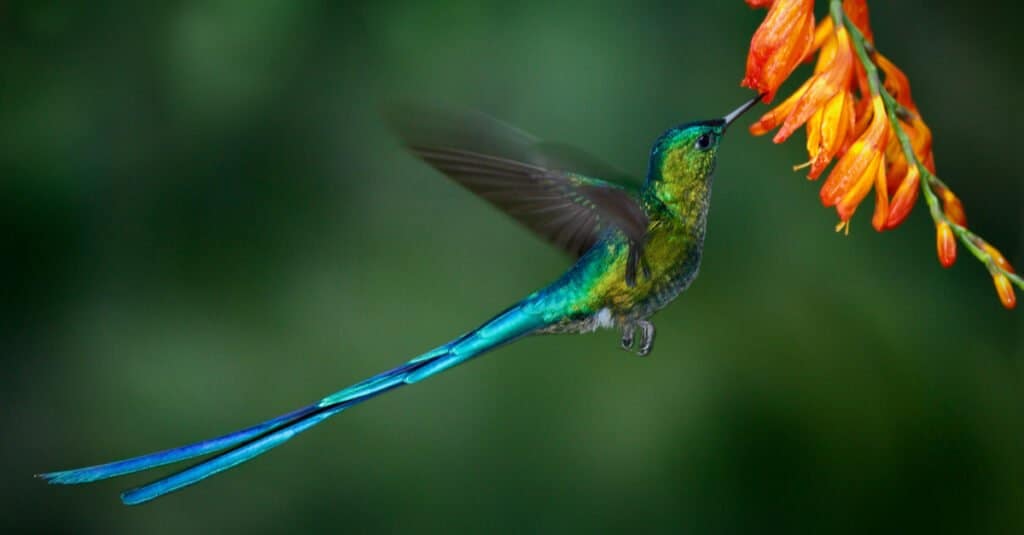
Hummingbirds range throughout North and South America.
©Ondrej Prosicky/Shutterstock.com
Most modern hummingbirds originate from the Americas, with the vast majority coming from South America. They range from Alaska in the north to Tierra del Fuego in the south, and also in the Caribbean. To be exact, hummingbirds primarily live in Ecuador, Colombia, and Mexico, with fewer species living elsewhere. That said, some earlier hummingbird species could also have come from Europe or Eurasia. Today, the only place outside of the Americas where you can find hummingbirds is eastern Russia. Most hummingbirds live in tropical and subtropical environments, but a few adapted to temperate forests. During winter, most hummingbirds migrate south from more temperate climates to warmer habitats. For example, the rufous hummingbird migrates around 8,000 miles round-trip, which is incredible given its size. Comparatively, most smaller birds don’t migrate nearly as far, which is further testament to a hummingbird’s strength.
Physical Characteristics
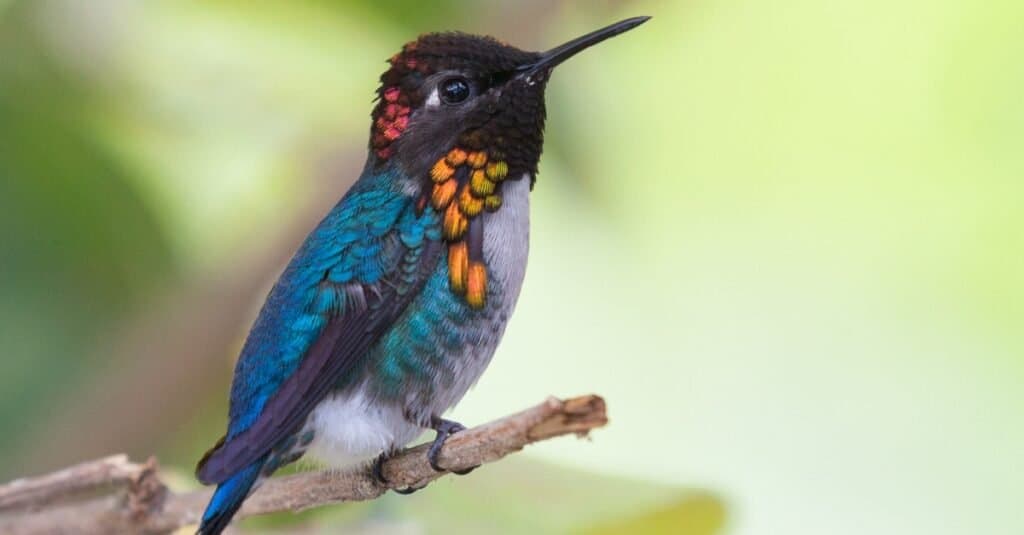
The bee hummingbird averages around two inches in length.
©iStock.com/epantha
Hummingbirds occur in all sorts of shapes and sizes. Generally, females measure larger than males in small species, while males measure larger than females in bigger species. For example, the bee hummingbird, the world’s smallest bird, measures only around 2 inches long. Meanwhile, the giant hummingbird, the largest hummingbird species, measures around 9 inches long. All hummingbirds sport long, curved bills specially designed to help them feed on flower nectar. That said, their bills can vary greatly in size and curvature, with adaptations varying based on local fauna. In addition, hummingbirds come in a range of colors, with males typically featuring brighter, more colorful plumage. Their feathers can appear in different colors depending on the lighting, shifting from green to blue to purple to red. Typically, males developed bright plumage as a part of courtship rituals and will ruffle their feathers to attract females.
Social and Reproduction Behavior

Hummingbirds do not mate for life.
©iStock.com/Salinger
Hummingbirds use their wings to create buzzing sounds to communicate with one another. Several basic messages include warning sounds when predators are near, threats against potential rivals, and mating intentions. Unlike some other bird species, hummingbirds do not mate for life. Some species enact elaborate courtship displays including diving through the air and trilling their wings. However, many males simply just wait for females to enter their territory before attempting to reproduce. In addition, male hummingbirds do not contribute to the raising of their young at all. Females hummingbirds bear the sole responsibility of building a nest and nesting the eggs. Most hummingbirds build a cup-shaped nest, typically made from lichen, moss, and other soft grasses. Hummingbirds lay the small eggs of any bird species, with eggs measuring little more than an inch long.
Diet and Feeding Behavior
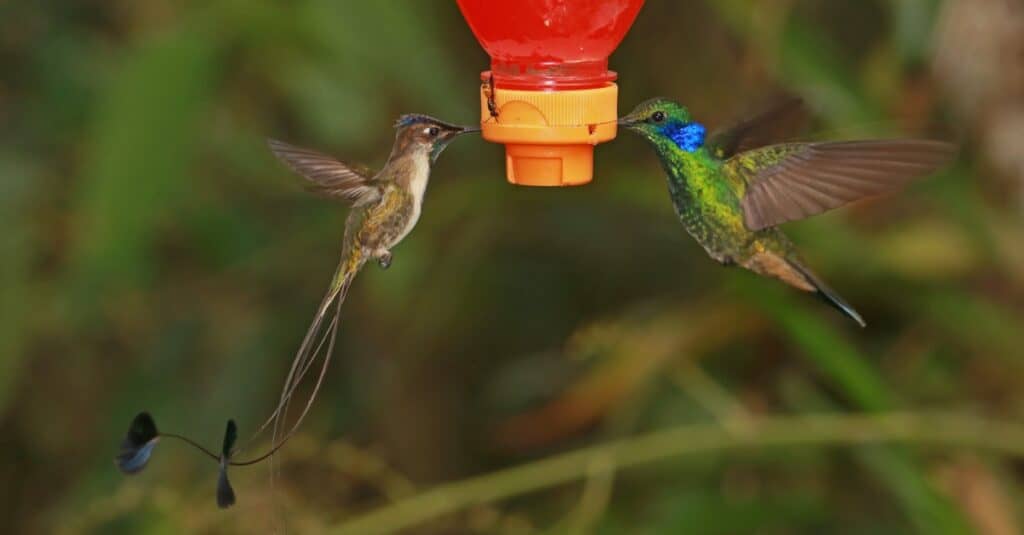
Hummingbirds primarily feed on nectar as well as insects.
©iStock.com/neil bowman
All hummingbirds are nectarivores, meaning that they primarily subsist on nectar from flowers. Using their long bills, they dip their beaks into flowers and then use their long tongues to lap up any nectar. A hummingbird’s bill can bend up to 25 degrees, which helps them to reach nectar in hard-to-reach areas. Nectar provides hummingbirds with the energy they need to fuel their fast metabolisms. While in flight, they have the highest metabolism of any animal, and their hearts can beat up to 1,260 times per minute. Given their metabolism, hummingbirds must eat efficiently and spend most of their time perching and resting. In addition to nectar, hummingbirds also eat a wide variety of insects. Common insects include mosquitoes, gnats, and fruit flies, as well as spiders. To catch their prey, hummingbirds will hover in insect swarms, thereby raising their chances of catching as many insects as possible.
Flight Capabilities
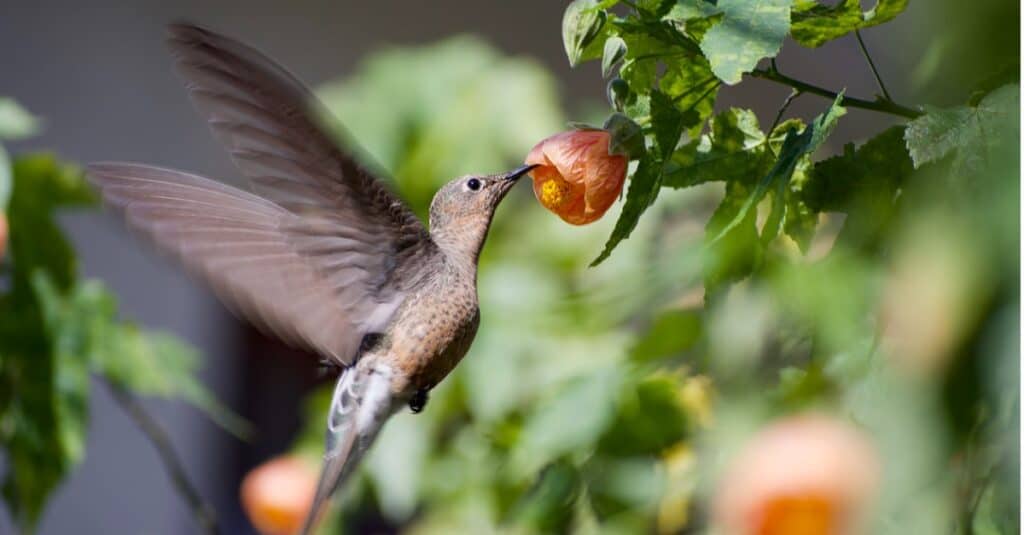
Hummingbirds can fly backward, as well as up, down, and sideways.
©Carlos M. Werner/Shutterstock.com
The hummingbird is the only bird that can fly backward. A hummingbird’s wings allow it to fly forward, backward, up, and down, as well as in figure-eight patterns. They can beat their wings up to 80 times per second, and generate much more force on their upstroke than other birds. This allows them to hover in place similar to how some insect species hover, rather than the “hovering” used by other birds. With their wings moving at such quick speeds, their flapping wings create a distinctive humming sound. This sound is where the hummingbird gets its name.
Ecological and Cultural Importance
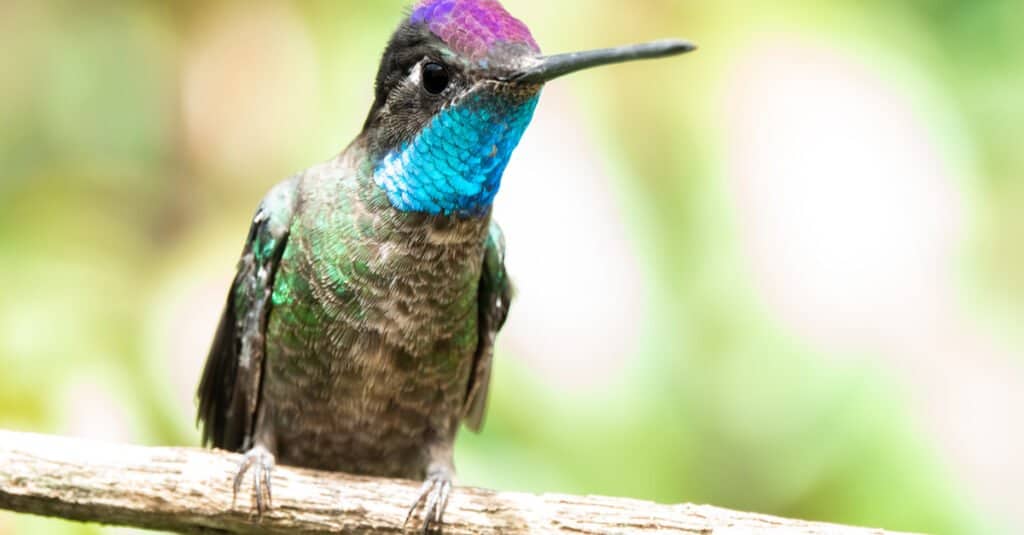
Hummingbirds are one of nature’s greatest pollinators.
©Jeroen Mikkers/Shutterstock.com
Hummingbirds serve a number of important ecological functions. Given their feeding requirements, they can visit hundreds of flowers in the space of a day. Their nectar requirements mean hummingbirds operate as one of nature’s most prolific pollinators. They not only pollinate flowers but also trees and other flowering plants in their environment. In addition, they also serve an important cultural function historically and today. Aztec people revered hummingbirds, and the Aztec god of war, Huitzilopochtli, was often depicted as a hummingbird. A number of other native peoples also told creation myths and tales about the hummingbird. Today, the Jamaica bird or doctor bird is the national bird of Jamaica.
Frequently Asked Questions About Hummingbirds
Can hummingbirds walk or hop?
Unlike some other species of bird, hummingbirds cannot walk or hop. Their legs are relatively weak, which means they can only shuffle small distances.
What is the most common species of hummingbird?
The ruby-throated hummingbird is the most common hummingbird species. It gets its name from the bright red throat feathers featured on the males. They range throughout the eastern half of North America.
How long do hummingbirds live?
Despite their fast metabolism, hummingbirds can live an exceptionally long time. While most only live between 3 to 5 years, some specimens can live up to 12 years old.
The photo featured at the top of this post is © iStock.com/McBenjamen
Thank you for reading! Have some feedback for us? Contact the AZ Animals editorial team.






